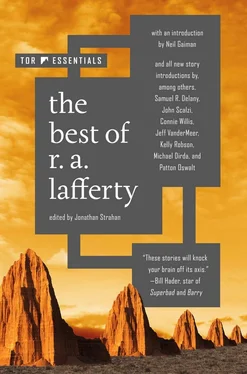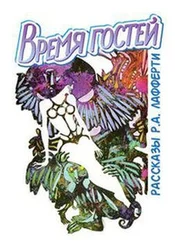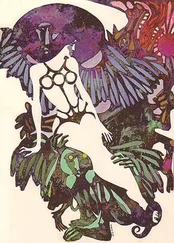“I wonder how he can sell trailer-loads of such stuff out of a little shack like that,” Slick puzzled, still not satisfied.
“Like the girl says, he cuts prices,” Boomer said. “Let’s go over to the Red Rooster and see if there’s anything going on. There always were a lot of funny people in that block.”
Introduction by Neil Gaiman
When I wrote to R. A. Lafferty as a very young man, I asked him about his favorite of his own short stories. He mentioned three stories that I had read and loved—“Ginny Wrapped in the Sun,” “Configuration of the North Shore,” and “Continued on Next Rock”—and one that I hadn’t. It was called “Ride a Tin Can.”
Shortly afterward, I bought a copy of Strange Doings, and read “Ride a Tin Can,” and was disappointed. It made me sad.
I think I wanted to be uplifted. I wanted the thing that Lafferty did where his apocalypses were joyful things one went into with delight. And here were the Shelni race going into an apocalypse with joyful delight, and I walked away from the story feeling that I might just have read the saddest story in the world. I felt manipulated, because it was an ending that called for tears, told in a way that did not allow for tears. I did not trust tears anyway. “Ride a Tin Can” left me disappointed in Humanity. It was a story I could admire, but I could not love, and which I did not look forward to rereading.
As an older reader, I can love it: I can love it for the shape of the story, the three tiny tales that hover at the end of understanding; I love it for the worldbuilding that is never fully described, for the relationship between the Shelni and the Skokie and the frogs and the trees. I love it for Holly Harkel, a human woman who is goblin enough to talk to goblins under their tree-root home, goblin enough to ride a tin can herself.
It’s a story nobody else could have written, pulled off in a way nobody else would have imagined, that describes a genocide that hurts, without a word wasted.
I think, “We are better than this. Surely we must be better than this?” And I think, “How do you write a story like that anyway? Write a story like that, and make it look easy?”
But he does. Somehow he does.
It’s OK if you cry.
These are my notes on the very sticky business. They are not in the form of a protest, which would be useless. Holly is gone, and the Shelni will all be gone in the next day or two, if indeed there are any of them left now. This is for the record only.
Holly Harkel and myself, Vincent Vanhoosier, received funds and permission to record the lore of the Shelni through the intercession of that old correlator John Holmberg. This was unexpected. All lorists have counted John as their worst enemy.
“After all, we have been at great expense to record the minutiae of pig grunts and the sound of earthworms,” Holmberg told me, “and we have records of squeakings of hundreds of species of orbital rodents. We have veritable libraries of the song and cackle of all birds and pseudo-ornins. Well, let us add the Shelni to our list. I do not believe that their thumping on tree roots or blowing into jug gourds is music. I do not believe that their singsong is speech any more than the squeaking of doors is speech. We have recorded, by the way, the sound of more than thirty thousand squeaking doors. And we have had worse. Let us have the Shelni, then, if your hearts are set on it. You’ll have to hurry. They’re about gone.
“And let me say in all compassion that anyone who looks like Miss Holly Harkel deserves her heart’s desire. That is no more than simple justice. Besides, the bill will be footed by the Singing Pig Breakfast Food Company. These companies are bitten by the small flea of remorse every now and then and they want to pitch a few coins into some fund for luck. It’s never many coins that they want to pitch; the remorse bug that bites them is never a very large one. You may be able to stretch it to cover your project though, Vanhoosier.”
So we had our appropriation and our travel, Miss Holly and myself.
Holly Harkel had often been in disrepute for her claims to understand the languages of various creatures. There was special outrage to her claim that she would be able to understand the Shelni. Now that was odd. No disrepute attached to Captain Charbonnett for his claim to understand the planetary simians, and if there was ever a phony claim it was this. No disrepute attached to Meyro-witz for his claim of finding esoteric meanings in the patterns of vole droppings. But there seemed something incredible in the claim of the goblin-faced Holly Harkel that not only would she be able to understand the Shelni instantly and completely but that they were not low scavenger beasts at all, that they were genuine goblin people who played goblin music and sang goblin songs.
Holly Harkel had a heart and soul too big for her dwarfish body, and a brain too big for her curious little head. That, I suppose, is what made her so lumpy everywhere. She was entirely compounded of love and concern and laughter, and much of it bulged out from her narrow form. Her ugliness was one of the unusual things and I believe that she enjoyed giving it to the worlds. She had loved snakes and toads, she had loved monkeys and misbegottens. She had come to look weirdly like them when we studied them. She was a snake when we studied them, she was a toad when they were our subject. She studied every creature from the inside of it. And here there was an uncommon similarity, even for her.
Holly loved the Shelni instantly. She became a Shelni, and she hadn’t far to go. She moved and scooted and climbed like a Shelni. She came down trees headfirst like a Shelni or a squirrel. She had always seemed to me to be a little other than human. And now she was avid to record the Shelni things “—before they be gone.”
As for the Shelni themselves, some scientists have called them humanoid, and then braced themselves for the blow and howl. If they were humanoid they were certainly the lowest and oddest humanoids ever. But we folklorists knew intuitively what they were. They were goblins pure and simple—I do not use the adjectives here as cliché. The tallest of them were less than three feet tall; the oldest of them were less than seven years old. They were, perhaps, the ugliest creatures in the universe, and yet of a pleasant ugliness. There was no evil in them at all. Scientists who have tested them have insisted that there was no intelligence in them at all. They were friendly and open. Too friendly, too open, as it happened, for they were fascinated by all human things, to their harm. But they were no more human than a fairy or an ogre is human. Less, less, less than a monkey.
“Here is a den of them,” Holly divined that first day (it was the day before yesterday). “There will be a whole coven of them down under here and the door is down through the roots of this tree. When I got my doctorate in primitive music I never imagined that I would be visiting Brownies down under tree roots. I should say that I never so much as hoped that I would be. There was so much that they didn’t teach us. There was even one period in my life when I ceased to believe in goblins.”
The latter I do not believe.
Suddenly Holly was into a hole in the ground headfirst, like a gopher, like a ground squirrel, like a Shelni. I followed her, letting myself down carefully, and not headfirst. I myself would have to study the Shelni from the outside. I myself would never be able to crawl inside their green goblin skins, never be able to croak or carol with their frog tongues, never feel what made their popeyes pop. I myself would not even have been able to sense out their dens.
Читать дальше




![Рафаэль Лафферти - Дни, полные любви и смерти. Лучшее [сборник litres]](/books/385123/rafael-lafferti-dni-polnye-lyubvi-i-smerti-luchshe-thumb.webp)
![Рафаэль Лафферти - Лучшее [Сборник фантастических рассказов]](/books/401500/rafael-lafferti-luchshee-sbornik-fantasticheskih-ra-thumb.webp)